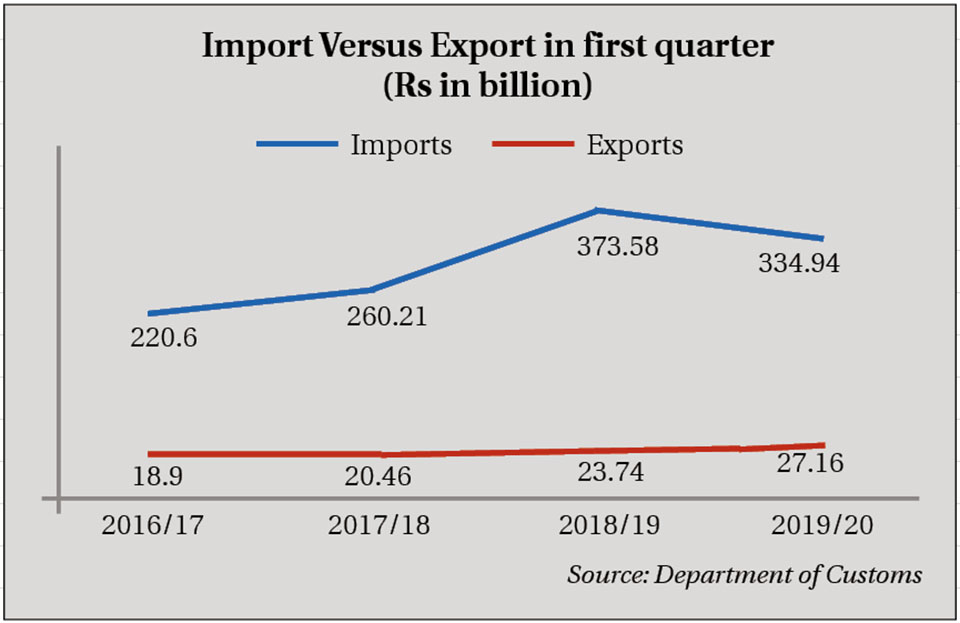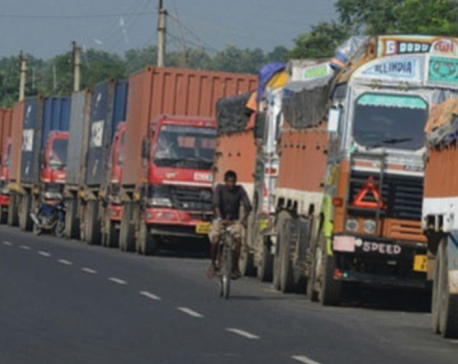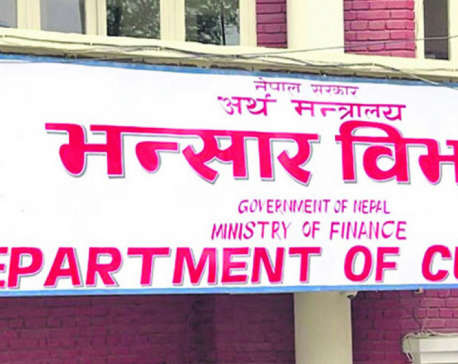
OR
Trade deficit shrinks by 12% in first quarter
Published On: November 2, 2019 07:50 AM NPT By: RAJESH KHANAL

KATHMANDU, Nov 2: Nepal’s trade deficit in the first three months of the current fiscal year declined by an impressive 12 percent, giving the country some respite from the ever-worsening balance of trade over the past several years.
Figures maintained by the Department of Customs show that the improvement in the trade situation is the result of a significant reduction in imports and notable rise in export earnings.
According to the department, Nepal had spent Rs 334.94 billion in imports between mid-July and mid-October, which is down by 10.34 percent compared to the imports of the same period in the last fiscal year. On the other hand, the country’s export earnings soared by 14.41 percent to Rs 27.16 billion during the period.
With an improvement in trade balance, the import to export ratio has also declined to 12.3:1, which means that Nepal spends Rs 12.3 for import for every export worth Re 1. During the same period last year, the ratio was 15.7:1.
Baikuntha Aryal, secretary at the Ministry of Industry, Commerce and Supplies, said the improvement in trade balance is an outcome of the policy reforms made by the government to tackle the ever-expanding trade deficit. “The government has now implemented measures to restrict import of luxury goods and boost exports and this has slowly started showing the results,” said Aryal.
Nepal exported goods worth Rs 17.87 billion to India, almost 66 percent of the total export earnings during the period. Likewise, the total import expenses made to the southern neighbor stood at Rs 207.41 billion, which is 62 percent of the total imports during the period. Over the period, the trade deficit with India has fallen to Rs 189.54 billion from Rs 222.95 billion.
Navaraj Dhakal, spokesperson at the Ministry of Commerce, said the government in recent days has been working to effectively implement its trade deficit minimization strategy, which was enforced a few months ago.
According to him, the government has focused on reducing imports through both the tariff and non-tariff measures. “On the tariff side, the government has hiked the duty on final goods while reducing the duty on the import of raw materials,” said Dhakal.
In the past few months, Nepal had also carried out several rounds of trade talks with its major trading partner countries including India, Bangladesh, Bhutan and China. “This has also enabled the exporters to benefit from the simplification in the transit operations and eased the customs procedures in these countries,” said Dhakal.
Since last December, the government has raised the export incentives in the country’s major exportable items to 3-5 percent from 1-2 percent. As per the Ministry of Industry, Commerce and Supplies, the government provides export incentives to the goods that have at least 50 percent value addition inside the country.
Mostly, processed tea, processed coffee, handicrafts and wooden crafts, leather goods, handmade papers and related products, processed herbs and oil products, precious stones and jewelries, ginger, cardamom and finished goods made out of allo are eligible for the incentive of five percent cashback.
Dhakal said the government’s revision in the rate of export incentives, simplification of the banking procedures to receive the incentives and extension in the basket of exportable goods for the incentives had also played role in boosting the country’s export earnings.
Implementation of one-door system for exporters and diversification on the issuance of the certificates of origin to the traders have also helped increase the exports, according to Dhakal.
“The ministry has now allowed a number of traders’ associations at the local levels also to issue the certificates of origin to traders to facilitate the exports.”
You May Like This

Nepal’s foreign trade declined around Rs 37 billion in the first 10 months of current FY
KATHMANDU, May 21: Nepal’s total foreign trade declined Rs 36.69 billion in the first 10 months of the current fiscal... Read More...

Focus on strengthening internal production capacity to reduce trade deficit
While export earnings declined 7.23 percent, import expenses fell 3.09 percent in the first half of the current fiscal year... Read More...

Nepal records exports worth Rs 100 billion as imports exceed Rs one trillion in the first eight months of current FY
KATHMANDU, March 23: During the first eight months of the current Fiscal Year 2022/23, Nepal has imported goods worth one... Read More...







Just In
- NRB to provide collateral-free loans to foreign employment seekers
- NEB to publish Grade 12 results next week
- Body handover begins; Relatives remain dissatisfied with insurance, compensation amount
- NC defers its plan to join Koshi govt
- NRB to review microfinance loan interest rate
- 134 dead in floods and landslides since onset of monsoon this year
- Mahakali Irrigation Project sees only 22 percent physical progress in 18 years
- Singapore now holds world's most powerful passport; Nepal stays at 98th











Leave A Comment